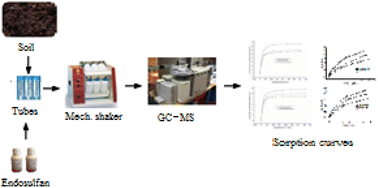Kinetic and isotherm studies on the adsorption–desorption of technical-grade endosulfan in loamy soils under Theobroma cacao L cultivation, Southwestern Nigeria
Abstract
The fate of pesticides in soils is dependent on the adsorption–desorption kinetics, isotherms and soil types. Interactions of technical-grade endosulfan with top soils (top 0–15 cm) from CRIN, Igba and Sore Bale Theobroma cacao L farms in Southwestern Nigeria were studied using the OECD batch isotherm method. The soils were predominately basic (pH 7.1–8.33), while the orders of the total organic carbon (1.32–2.03%) and clay content (10.92–19.11%) were CRIN > Igba > Sore Bale and Igba > CRIN > Sore Bale, respectively. The adsorption of endosulfan was bi-continuous: initially rapid, followed by a slow process, with pseudo-equilibria and plateaus formed between 120 and 240 min. Endosulfan adsorption by soils was due to their greater affinity for organic matter than clay. The adsorption rates fitted better into a pseudo-second-order model (PSOM) than a pseudo-first-order model (PFOM), with the adsorption (kads) and desorption (kdes) rate constants for both isomers ranging from 7.60 × 10−3 to 11.52 × 10−3 min−1 and 1.39 × 10−3 to 3.42 × 10−3 min−1, respectively (i.e. kads > kdes), while kdes (β-isomer) > kdes (α-isomer) for PFOM, but k2_ads < k2_des for the two isomers in PSOM. Additionally, α-endosulfan was adsorptive, with the β-isomer more prone to leaching; both isomers were moderately leachable according to their FAO mobility rankings. The adsorption model did not fit well into a Langmuir isotherm (R2 ≤ 0.948); however, the desorption model did (R2 ≥ 0.991). Freundlich isotherm plots fitted better (R2 ≥ 0.992) and exhibited non-linear curves of types L and S for the adsorption and desorption processes, respectively. The adsorption/desorption coefficients (Kfads and Kfdes) and strengths of adsorption/desorption (1/nads and 1/ndes) for both isomers were from 1.33 ± 0.10 to 4.81 ± 0.18 μg1−1/n (mL)1/n g−1 and 0.503 to 1.402, respectively, in all soils, with Kfads < Kfdes and 1/nads < 1/ndes. Positive hysteresis was observed. CRIN exhibited the highest hysteresis index. The Kfom values were ≤127.14 ± 6.23 mL g−1, while the values of the standard free energy were ΔG0 = −5.11 to −14.05 kJ mol−1 K−1, depicting a spontaneous physisorption process, driven by van der Waals forces, among others. Endosulfan could easily be leached and contaminate the surface and groundwater owing to its faster PSOM desorption rate constant, but TOM and clay could be used as mitigants to reduce its mobility in soils as they have significant affinity for the pesticide.

- This article is part of the themed collection: Topic Collection: Agriculture, Soil and Plants


 Please wait while we load your content...
Please wait while we load your content...